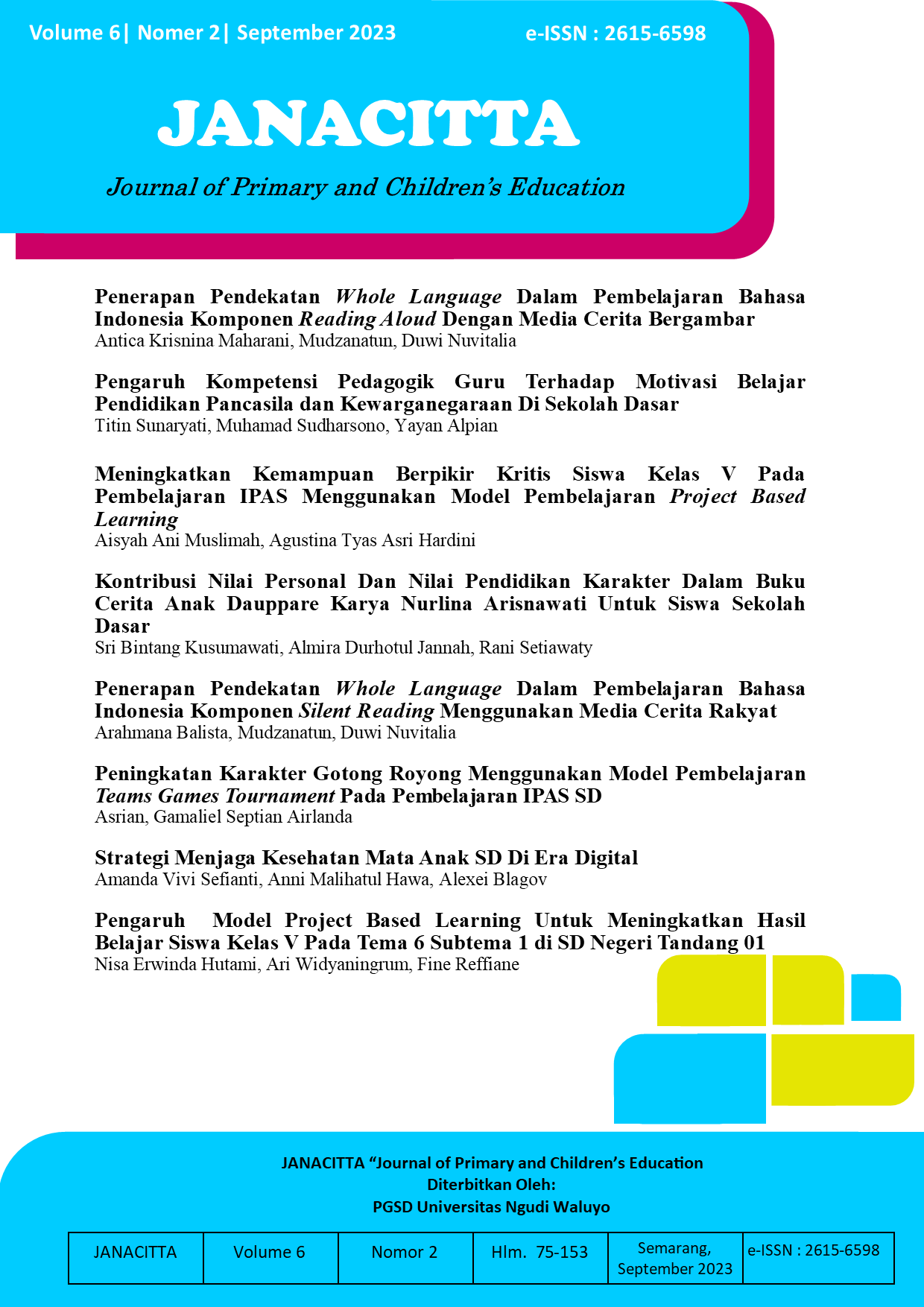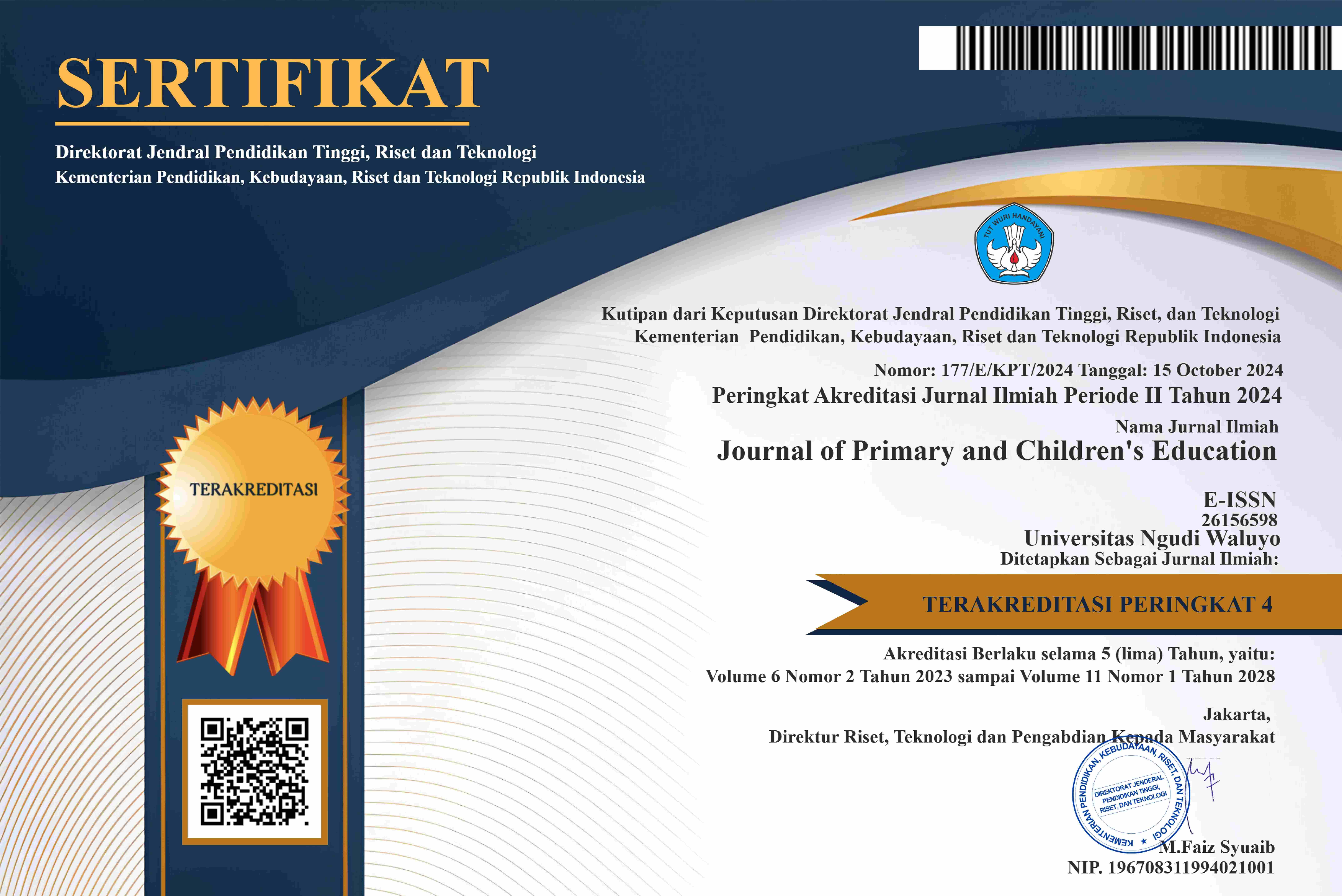Strategi Menjaga Kesehatan Mata Anak SD Di Era Digital
DOI:
https://doi.org/10.35473/jnctt.v6i2.2609Abstract
Abstract
The development of digital technology has brought significant changes to the lifestyle of elementary school (SD) children. The use of electronic devices such as smartphones, tablets and computers has become an integral part of daily work. However, it is increasingly important to be aware of the negative impact of excessive screen exposure on children's eye health. The aim of this research is to identify effective strategies for maintaining the eye health of elementary school children in the digital era. In short, it can be said that maintaining the eye health of elementary school children in the digital era is a challenge that requires serious attention. The data collection technique involves collecting several previous studies to answer strategies for maintaining eye health for elementary school children in the digital era. The research results are that with an approach that includes education, supervision and adequate rest, we can mitigate the negative impact of screen exposure on children's eye health. It is hoped that the results of this research will provide valuable guidance for parents, teachers and relevant stakeholders to protect children's eye health in an increasingly digital era.
Abstrak
Perkembangan teknologi digital membawa perubahan signifikan pada gaya hidup anak sekolah dasar (SD). Penggunaan perangkat elektronik seperti smartphone, tablet, dan komputer sudah menjadi bagian tak terpisahkan dalam pekerjaan sehari-hari. Namun, semakin penting untuk mewaspadai dampak negatif paparan berlebihan layar tersebut terhadap kesehatan mata anak. Tujuan dari penelitian ini adalah untuk mengidentifikasi strategi efektif untuk menjaga kesehatan mata anak sekolah dasar di era digital. Secara singkat dapat dikatakan bahwa menjaga kesehatan mata anak Sekolah Dasar di era digital merupakan tantangan yang memerlukan perhatian serius. Teknik pengumpulan data dengan cara mengumpulkan beberapa penelitian terdahulu untuk menjawab strategi menjaga kesehatan mata anak SD di era digital. Hasil penelitian yakni dengan pendekatan yang mencakup edukasi, pengawasan dan istirahat yang cukup, kita dapat memitigasi dampak negatif paparan layar terhadap kesehatan mata anak. Hasil penelitian ini diharapkan dapat memberikan panduan berharga bagi orang tua, guru, dan pemangku kepentingan terkait untuk melindungi kesehatan mata anak-anak di era yang semakin digital.
References
Liu, S. M., Chang, F. C., Chen, C. Y., Shih, S. F., Meng, B., Ng, E., ... & Fang, W. T. (2021). Effects Of Parental Involvement In A Preschool-Based Eye Health Intervention Regarding Children’s Screen Use In China. International Journal Of Environmental Research And Public Health, 18(21), 11330.
Abdulatif, S., & Lestari, T. (2021). Pengaruh gadget terhadap perkembangan sosial anak di masa pandemi. Jurnal Pendidikan Tambusai, 5(1), 1490-1494.
Rahmania, N., Dorahman, B., & Sunaryo, S. (2023). Analisis Dampak Negatif Penggunaan Gadget Ditinjau Dari Perilaku Siswa. Seroja: Jurnal Pendidikan, 2(4), 512-519.
Johnson, Scholes, Whittington. (2016). Exploring Corporate Strategy
Siagian Sondang P. (2014). Manajemen Sumber Daya Manusia. Jakarta: Bumi Aksara.
Susilo, B. (2019). Dampak positif perkembangan teknologi informasi terhadap tumbuh kembang anak. SINDIMAS, 1(1), 139-143.
Sasia, K., Dewi, F. I. R., Doringin, F., & Budiana, M. W. (2021). Edukasi Dan Pemeriksaan Kesehatan Mata Sejak Dini Untuk Mengatasi Peningkatan Kasus Miopia Pada Siswa SMA Di Jabodetabek. Prosiding Serina Untar Mbkm, 102-109.
Yuhandra, E., Akhmaddhian, S., Fathanudien, A., & Tendiyanto, T. (2021). Penyuluhan hukum tentang dampak positif dan negatif penggunaan gadget dan media sosial. Empowerment: Jurnal Pengabdian Masyarakat, 4(01), 78-84.
Castelluccio, Michael. (2007). Gadget AnEssay.
Pebriana, P. H. (2017). Analisis penggunaan gadget terhadap kemampuan interaksi sosial pada anak usia dini. Jurnal Obsesi: Jurnal Pendidikan Anak Usia Dini, 1(1), 1-11.
Putri, A. K., Reynanda, S. A., & Raisa, R. R. (2021). Pengaruh Pembelajaran Daring Terhadap Kesehatan Mata di Masa Pandemi. Jurnal Komunitas Kesehatan Masyarakat, 3(2), 26-38.
Husna, H. N., & Widia, C. (2019). Skrining Ketajaman Penglihatan pada Siswa SDN. Media Karya Kesehatan, 2(1).
Mufid, Ahlul Himayati, dkk. (2023). Analisis Video Pembelajaran Simbol Pancasila Melalui Aplikasi Canva Kelas 1 SDN Plamongansari 02. Journal of Primary and Children's Education, 6(1), 1.
Yudianto, A. (2017). Penerapan Video Sebagai Media Pembelajaran.
Mustika, Banjar Hening dkk. (2019). Efektivitas Model Project Based Learning Berbantu Mind Map Terhadap Hasil Belajar Siswa Kelas IV. Journal of Primary and Children’s Education, 5(1), 2.
Downloads
Published
How to Cite
Issue
Section
License
Copyright notice:
- Authors retain copyright and grant the journal right of first publication with the work simultaneously licensed under Creative Commons Attribution License that allows others to share the work with an acknowledgement of the work's authorship and initial publication in this journal.
- Authors are able to enter into separate, additional contractual arrangements for the non-exclusive distribution of the journal's published version of the work (e.g., post it to an institutional repository or publish it in a book), with an acknowledgement of its initial publication in this journal.
- Authors are permitted and encouraged to post their work online (e.g., in institutional repositories or on their website) prior to and during the submission process, as it can lead to productive exchanges, as well as earlier and greater citation of published work (The Effect of Open Access)







